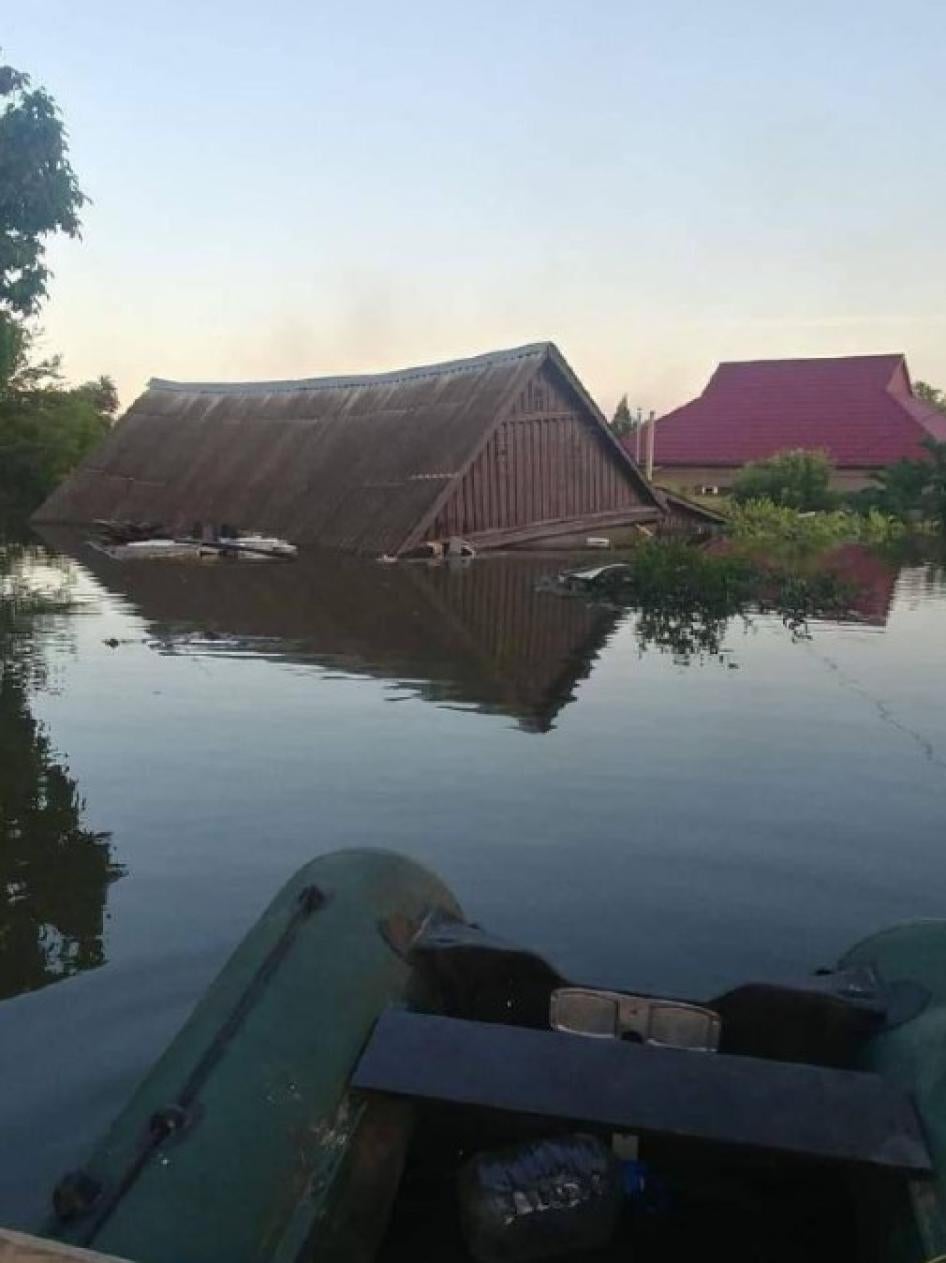Tanya lives on Nizhnyaya Street in Oleshky, a town on the Dnipro’s left bank that Russian forces have occupied since April 2022. Ninety percent of Oleshky was flooded, with some areas practically disappearing underwater.
Tanya is one of the 16 people – residents from Oleshky and nearby areas, and volunteers from the right bank who have been trying to help – I spoke with by phone in recent days. They said that by late afternoon on June 6, Russian occupation authorities shut the town down for entry and exit, effectively locking people inside. At checkpoints, they turned around those who tried to flee in cars, while it was still possible, saying things like: “Haven’t you been waiting it out hoping for Ukraine to come back? Go back and wait some more.” Russian soldiers also blocked volunteers and others wanting to help from entering the town. A volunteer who tried to enter Oleshky on June 8 told me: “We told them we were bringing food and water for the people and that we were unarmed. They [Russian soldiers] told us to turn around, drive, and not look back. Then they shot [their guns] in the air for good measure.”
Volunteers and residents repeatedly told me that in the hours and days immediately following the dam disaster, Russian authorities did not warn people of the impending dangers or carry out timely evacuations. Russian cell networks stopped working and the only information residents were receiving came from Ukrainian Telegram channels, swiftly set up by townspeople and volunteers, and Ukrainian news outlets.
Soon there was no water, gas, or electricity services in Oleshky. Their phone batteries dying, those who were stranded had no way of connecting with the outside world. Residents who had boats started rescuing people who were yelling for help from the rooftops of their flooded houses. Russian emergency services, they told me, were nowhere to be seen.
People said that with no official information or public announcements from the occupation authorities, it was hard for them to immediately understand the degree of the danger. As a result, many were stranded.
Tanya, like many others, initially thought that she could wait things out. But by the afternoon of June 6, when she looked out the window and saw the water levels on her street rising quickly, she ran outside in her housedress and slippers with her two small dogs and rushed to her son’s house. On the way, she saw Russian soldiers riding in a jeep with Russian emergency service markings on it. She pleaded to them for help but they ignored her and drove off after asking her where they could find a local official. Several residents said that they repeatedly tried calling the Russian emergency services number in Oleshky but no one picked up.
Tanya got to her son’s house. For six hours, she and another neighbor sheltered in the attic while the water continued to rapidly rise. When a family friend finally came to rescue them in a rubber boat, Tanya swam to it from the attic window. She was not able to save her dogs.
Last month, a shell fragment killed Tanya’s husband in their garden. Now flooding has destroyed her house, her son’s house, and another house her husband owned in Oleshky, the town she’s lived in her entire life. “For me, it’s been a loss after loss after loss. I can’t bear it anymore,” she said.
A Ukrainian official told me that at least nine people died in Oleshky from the flooding as of June 16, but the exact toll isn’t known.
Russian occupation authorities apparently started conducting sporadic evacuations from Oleshky almost a week later on June 13. Most residents whom I spoke with wanted to leave but had no information about this. One man told me he would go to a Ukraine-controlled area if he could, but he couldn’t imagine moving to Russia or another Russia-occupied area and was afraid to leave his house behind.
Water levels are now falling, but people in Oleshky are in dire need of humanitarian aid. Halyna, a woman in her 60s, told me she had to walk six kilometers to the town center, which has not been flooded, and wait for hours to receive aid, only to have supplies run out before her number was called. She then went to a friend’s house to boil some water and carried it six kilometers home to make tea for her 83-year-old mother. Two other older women said that they were unable to get humanitarian aid because the distribution point was too far away, and they had no way of getting there.
Most parts of Oleshky are still without electricity, natural gas, or water. Those who have running water worry about water contamination and infection due to flooded cemeteries and water filtration points.
Humanitarian needs will only get more acute in the coming days and weeks. Older people and people with disabilities being supported at home, and those that support them, will be particularly affected.
Both the International Committee of the Red Cross and the United Nations Office for the Coordination of Humanitarian Affairs have issued statements that they are standing by to help people on the right and left bank areas affected by the flood, including Oleshky, pending security guarantees from the Russian authorities that, to date, they have not received.
The longer Russian authorities fail to act, the greater the risks for people in places like Oleshky.
International law of occupation requires Russian authorities to ensure that the humanitarian needs of the population in the areas they effectively control are met. In Oleshky and other Russia-occupied areas, the authorities are failing at that obligation. Ukrainian civilians, once again, are paying the price.








